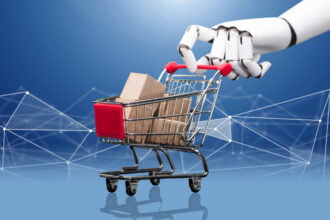Big data technology is increasingly being used in e-commerce. Analysts predict that global e-commerce companies will spend $6.2 billion on big data by 2025.
There are a number of benefits of using big data in e-commerce. One of the most important benefits lies in understanding the customer journey and optimizing their experience to maximize conversions.
Data Analytics is Important for Understanding Customer Behavior in eCommerce
Nowadays, online shopping is getting increasingly popular, as it is possible to purchase nearly all sorts of goods from the comfort of your home. With the growing interest in e-commerce platforms, the market competition is also getting even harsher?today’s customers seek a personalized and seamless shopping experience.
A lot of companies are using machine learning to create online stores more easily. However, they have also found that big data and AI solutions can be even more useful for understanding their customers.
This way, it is of utmost importance to be able to easily attract new customers and turn them into loyal ones. Here, a customer journey map (CJM) comes to the rescue.
What is a customer journey map?
A customer journey map is a visual representation of experiences a customer has with your online store: from the first touch with you to completing the purchase. With the help of journey maps, you can capture the end-to-end experience your customer undergoes that resulted in a purchase or a drop-off.
With a CJM at hand, you will understand the desires and expectations of your customers, examine their experience along the journey, as well as see the blind spots and experience flaws that need to be addressed. Based on that, you can improve customer experience to increase conversions and boost revenue.
Building an e-commerce customer journey map with big data will be easier when you know what steps to take.
Now, we will explore some best practices for creating a CJM for an e-commerce store with the right data analytics tools.
The preparation work
Before you get down to your journey map with the right data analytics insights, there is some groundwork to do.
Step #1. Define objectives
First, set clear goals that you want to achieve through customer journey mapping. For this purpose, you can bring together cross-department team members to agree on the target objectives. These may include increasing the conversion rate, reducing the number of refunds, encouraging reviews, etc. When the exact goals are specified, it is easier to implement improvements where needed and measure the results.
Step #2. Set the scope
It might be challenging to map the whole customer journey at once. You might want to begin with journey stages that need your attention as per your current goals or that you are well familiar with. You need to make sure that you have the right parameters established before you can start using data analytics to optimize your customer journey.
For example, if you want to understand why your customers decide to bounce even if they have already added products to the cart, you can pay attention to the checkout stage. For many online stores, cart abandonments occur pretty frequently?this is the way most people browse e-commerce websites. The reasons may vary: extra fees, poor delivery conditions, forced sign-up, website timeouts, etc. This way, it is crucial to get to the root of the problem and explore how to improve customer experience at this stage.
Step #3. Profile your buyer persona
Your customer journey won?t be complete without personas?a generalized representation of your customers with their expectations, goals, and behavior. So split your customers into segments based on common patterns (e.g. behavioral ones) to create personas.
In addition, persona profiles are extremely useful? you will have all customers? data at hand. Apart from the information about goals, motivations, background, frustrations, and other relevant information, you can also add a name and a best-fit photo to make a persona look realistic and relatable. Use the data you already have (e.g., from your CRM software) and do some research. Also, be sure to interview your current customers to better understand their needs and pains.
Step #4. Gather data on your buyers? journey
Now that you have created your personas, it?s time to embark on collecting information about their journeys.
Online data is a great asset that illustrates the real-world behavior of your customers.
To acquire real-time user data, use such web analytics tools as Google Analytics, Google Tag Manager, HotJar, etc. Furthermore, the Net Promoter Score is a golden standard for measuring customer experience and loyalty. Don?t limit yourself to the data gathered using web analytics tools only?talk to your cross-functional teammates, especially those who work in close contact with customers. After a knowledge-sharing session, you can also ask these colleagues to share some customer quotes and add them to the map for further use.
Actual mapping
Now, you can start visualizing your customer journey. Relying on the scope set, identify the stages your customers go through when interacting with your online store, the goals they pursue, processes, main pain points, and so on.
Step #1. Split the journey into stages and identify touchpoints for each
Outline the points where a customer comes in contact with your business. These may include a website homepage, a checkout page, a courier, a customer service operator, etc. Below are the example stages of your customers? purchase experience with possible touchpoints.
- Placing an order. A customer completes the purchase at the checkout page and requests a delivery.
- Order confirmation. Possible touchpoints here are a confirmation email or a customer service specialist.
- Waiting for the delivery. The touchpoints may be a confirmation email, a customer service manager, or a GPS tracking service.
- Receiving the order. Finally, the order finds its recipient. The touchpoints may be a package and courier service.
- Dealing with paperwork. The main touchpoints may be a courier service or documents.
Step #2. Add customer goals and expectations
This will let you see what your customers look for at each stage and how your company can align its services with buyers? needs. The examples are as follows: ?finding necessary products with minimum effort? at the search stage or ?receiving the delivery ASAP? after confirming your order.
Step #3. Find problems and enlist improvement opportunities
Web page timeout, hard-to-navigate product pages, low-quality images, poor delivery conditions, etc., can impact consumer experience greatly. Identify the core paint points that can destroy the experience. Then, brainstorm ideas that help you improve every single point and reflect them on the journey map.
Step #4. Include Moments of Truth
Moments of truth (MoTs) define whether a customer makes or breaks the relationship with your brand. For an e-commerce store, MoTs could be a checkout page or a call center. These are the most powerful moments in buyers? journeys, so make them customer-friendly.
The Right Process for Using Data Analytics to Map the Customer Journey
A CJM provides a comprehensive view of your customers? purchase journey with data analytics. It will help to see how you can ensure buyers have a unique and personalized experience across all touchpoints and channels in your e-commerce store.
Don?t put your customer journey map on the shelf once you complete it and present it to stakeholders. The customer journey is evolving, so should your map. Regularly review and update your CJM, while enhancing it with new findings and insights.










